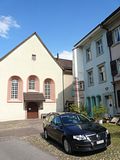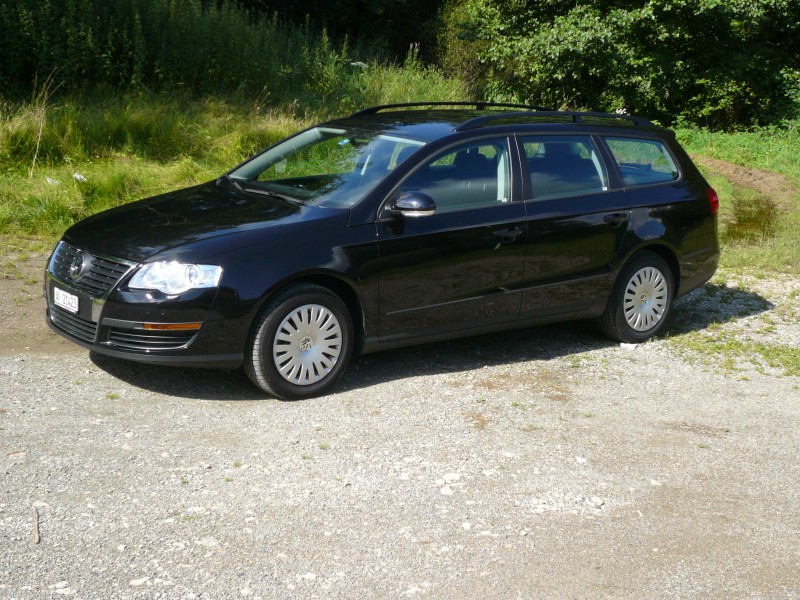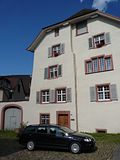















The first few miles were done late on Saturday evening from the airport to the hotel, in the dark and pouring rain. Indeed, at this point, I had not spotted the DSG markings, so I got in, adjusted the seats and mirrors and drove 5km, and parked up for the night. Even on this short journey, it was evident that this was a far more refined application of the much deployed VAG 2.0 TDI unit than I had experienced in the A3 and A4 loan cars of a couple of years ago. The automatic gearbox seemed to suit it quite well, providing a very smooth almost seamless transition from rest to 100 km/h on the brief autobahn part of the journey, before tackling the last 1km on a road-work infested road in Glattbrugg-Opfikon. Next morning, in the daylight, my favourable first impressions continued. There is still no doubting that this is a diesel when you fire up the engine – a task performed by pushing the whole key in further than its natural resting position in the slot to the right of the wheel, and delightfully simple compared to some of the complex “key-less” starting procedures you experience in some other cars – but once underway, and especially at a cruising speed the engine note is subdued and does not give any aural clues that it is diesel and not petrol. In that respect, it beats the Mondeo TDCi engine quite easily. Being a diesel, it does have lots of mid-range torque, and although the red-line and the rev-limiter is set at a low 4,500 rpm, I actually found that acceleration was surprisingly brisk, and for sure very smooth. Leaving the gearbox in fully automatic mode, the gears changed readily, and really gave no indication especially in any shift between 5th and 6th that a gearchange had taken place.
However, the DSG gearbox is more than just an ordinary automatic, so it was time to move the lever over to the right and use it manually. I’m sure you would quickly get used to it, but in the one day, and 410km, that I drove the car, my experiences were mixed. Moving from standstill, and changing up was just delightful. Flick the lever forward a tad, and a smooth, and always perfectly timed upchange was executed. Gearing is high, so until you were doing about 90 – 100 km/h, 6th gear was no use to you, but even in 5th the refinement levels were good, so not a problem. My challenge was more with down-shifts. I was not brought up on pre-synchromesh gearboxes, where double-declutching was a must, but the technique would have been useful here, in the lower gears. Changes down in the upper gears were fine, with just a gentle increase in the revs making it clear you were now in a lower gear, just as a result of flicking the lever back. But from third to second, the increase in revs was quite a lot more noticeable, and if you were following the technique I was on a driving course of “gears to go, brakes to slow”, then approaching a road junction, and coming down from 4th to 3rd (OK), 3rd to 2nd became more jerky, and could lead to a less than smooth stop. I am sure that some of this was me, and my lack of familiarity with the technique, but it was worth commenting on, especially for anyone who first experiences DSG only on a short test drive, as I cannot imagine I would be the only person to experience this. There are some safeguards built in, so if you accelerate and hit the rev limit, the gearbox changes up for you, without your intervention, and similarly, when you come to a complete stop, it does go right down to first, even if you did not select it.
This car is also fitted with another feature which is becoming (sadly) more common – the electronic handbrake. However, I found this one easier to use than any other such device I have encountered. Push the button to the left of the wheel (it was an lhd car) to set it, and it lights up. Push it again to release it. Simple. I did not get the chance to test it out with difficult hill starts, but as the car was an automatic, most of the challenges these present would be solved with the auto transmission anyway. This trip did not involve a trip into the mountains, so the brakes did not get the punishment that I have meted out to other Swiss rental cars, but the brakes felt very safe and confidence inspiring, with none of the wooden brake feel that has bedevilled VAG cars for years. Maybe it is because as an Audi driver I have just got used to how their brake systems feel? Ride, handling and steering also gave no concern all being perfectly acceptable, though nothing remarkable.
Remembering that this is really a family car, then practicality and comfort should be high on the list. Well, I found the driver’s seat very comfortable, and easily adjusted to get my perfect driving position. I did not like the seat covering in this any more than that in the Mondeo – in fact it looked the same, as they had both been to the same supplier, but it was doubtless very practical. serviceable and probably hard wearing. Visibility from the driver’s seat to the front and sides was good, with good coverage from the mirrors. Rear view out of the central mirror was fine, but the relatively high window line, dark interior and shape of the car meant that reversing just felt slightly more awkward than the Mondeo, but not by much. With the seats adjusted to suit me, there was masses of space in the rear seats, and ample width for three adults to sit there in comfort. The rear seat squab is split on a 1/3 to 2/3 basis, and a small loop allows to you to pull the squab forward then lift it up, so you can drop the equally split backrests into the space, provided you have removed the rear headrests, creating a long flat loadspace, with some protection from the front seats. The luggage cover over the “boot” area is easily removed. The regular boot is large, and a good rectangular shape, with a moulded well at each side behind the wheel arches, where you could put small items out of the main luggage area, and I noted there were four chromed luggage ties at the side of the boot. There is a large well under the rear load floor, where a spare wheel should be, but in the absence of once, gives an additional useful storage area. Top marks for family practicality as an estate car. then.
In the cabin, I was impressed at how different this car felt from the Audi A4 range, especially since some of the individual parts are shared VAG inventory. The main dash design is notably different, sloping well away from the driver, and in the basic model, with no unpleasant trim adornment. Everything was clear and intuitive though, and I particularly like the blue-effect lighting on the instruments in the dark. I less liked the fact that the bottom half of the chrome rims around the dials did sometimes reflect in the windscreen. This was a basic spec car, but it did come with a good quality, intuitive radio/CD player, which allowed me to search Swiss, French and German stations, and it did have climate control as well as air con. It was not a particularly warm day, but the air con seemed to have to work quite hard to maintain the (low) temperature I set it, and this was noisier than I would have liked. At least the system was effective.
So, mostly a good story. That leaves the question whether this is a premium-esque product or not. I still cannot decide whether I would really rate this as a “better” car than the Mondeo, perhaps partly because comparing a 1.8 litre petrol manual with a 2.0 TDI automatic is not quite comparing like with like. If you really wanted a diesel, I think the Passat would win, as the Ford diesel is far less refined. That aside, it is not an easy decision. UK market perception, which inevitably colours judgement even if you try not to let it do so, does still class the Mondeo as a “rep car” whereas the Passat is a cut above, is less common, but is priced and depreciates accordingly. Buying a secondhand one, I am pretty sure that the Ford would appear to be better enough value, that it would make a compelling case for many people. Buying new, if you could get a large discount, may also give the same answer. And yet, I could quite understand why anyone would choose the Passat, and feel that they had the “best in class” car. However, for sure I would not want an entry level model, with the horrid plastic wheel trims, and the thin corner bumper inserts, and black paint. That really does just make the car look like you could only afford the “poverty spec”. Clever aspirational marketing by VW especially for image conscious markets? Perhaps…………………… so, perhaps I am swayed by image more than I would care to admit, then!

































